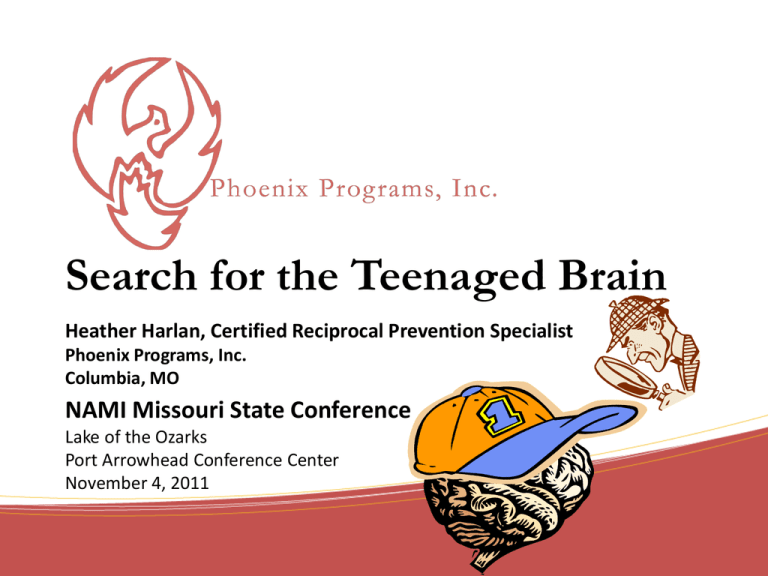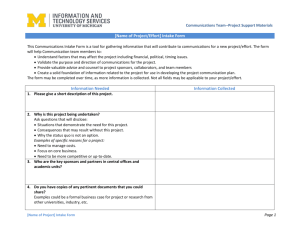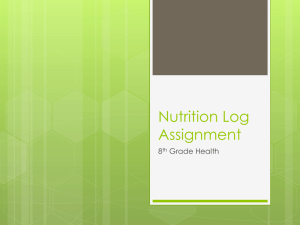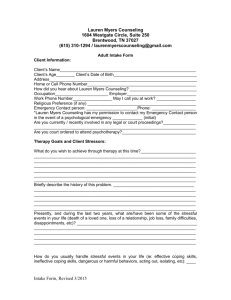PPT File
advertisement

Search for the Teenaged Brain Heather Harlan, Certified Reciprocal Prevention Specialist Phoenix Programs, Inc. Columbia, MO NAMI Missouri State Conference Lake of the Ozarks Port Arrowhead Conference Center November 4, 2011 Learning Objectives • Identify recent neurological discoveries in the brains of adolescents. • Understand needs of adolescents as a special population in prevention, treatment and recovery • Empower advocacy for evidence-based prevention, intervention, and treatment for youth. Identify recent neurological discoveries in the brains of adolescents. Most everybody (including scientists) had thought they knew what was different about adolescents. . . . . . . hair, hormones, and pimples. Didn’t connect astounding (irritating) changes in behavior, appetite, attention span, poor judgment, risky behaviors, and sleep patterns to their brains. 5 Scientists in 1997 were . surprised! Neuroscientist Dr. Jay Geidd, National Institutes of Health saw something he didn’t expect to see. 6 What Dr. Jay Geidd noted was neurological exuberance 7 Exhuberence? Scientists knew human frontal lobes continue to grow but thought it was over about age 2 yrs. forming gray matter, cell bodies—neurons treelike branches—dendrites , THEN • Age 11 for girls • Age 12 for boys 8 It begins to kill off brain connections. Some connections thrive. Used the most. 9 Use it or lose it. Enables human brain to specialize and adapt— connecting all those brain cells with neuropathways, enabling parts of the brain to work together smoothly. 10 Human brain growing well in the mid-20’s Ages 5 20 Blue represents maturing areas of the brain Blue represents maturing portion of the brain. 11 Human Brain Matures • Inside out • Back to front Last to mature—front Pre-frontal cortex—right behind your eyes and forehead 12 13 Pre-frontal cortex in humans last to mature • Reasoning • Motivation • Judgment • Resist impulses 14 Pre-frontal cortex in humans • Serves as “policeman” • Chief executive Helps us plan ahead. Asks, “What might happen IF . . . .? 15 Inhibitors demonstration 16 Inhibitors in the human brain: • Part of brain that “inhibits” our behavior • Keeps us from imitating everything we see/hear • Matures about age 25 New Research (Hot off the press): Published online Nature Journal October 19, 2011 and National Public Radio Health Blog Research suggesting teens’ IQ is not set in stone. IQ seems to be a gauge of acquired knowledge that progresses in fits and starts. • In this week's journal Nature, researchers at University College London report documenting significant fluctuations in the IQs of a group of British teenagers. • The researchers tested 33 healthy adolescents between the ages of 12 and 16 years using brain scans and IQ tests. • They repeated the tests four years later and found that some teens improved their scores by as much as 20 points on the standardized IQ scale. "We were very surprised," researcher Cathy Price, who led the project. She had expected changes of a few points. "But we had individuals that changed from being on the 50th percentile, with an IQ of 100, [all] the way up to being in the (top) 3rd percentile, with an IQ of 127." In other cases, performance slipped by nearly as much, with kids shaving points off their scores. In other words: Teen brains changing in even more ways than we knew. What is the ONE thing? The one thing the adolescent brain is best designed to do? 22 Primed, at the starting block, geared up, ready to go? 23 Learn 24 Learn? learning Neurologically, is the process of developing effective neuropathways. Reinforcers--neurotransmitters Make it possible for us to learn. 26 Ummmmmm . . .. What’s a reinforcer? 27 Reinforcer. A positive reward that increases a likelihood a behavior will be repeated is a positive reinforcer. or A negative response that increases the likelihood a behavior will diminish or stop. In the brain it comes in the form of chemical rewards. 28 When I think of my brain There’s a lot at stake So I’m gonna learn how To make a good brain great. Now from memory . . . Skill set Neurons fired together are wired together. Understand needs of adolescents as a special population in prevention, treatment and recovery Age of first use matters Youth who begin drinking before age 15 are 4 times more likely to become alcohol dependent than those who wait until they are 21. --PIRE (Pacific Institute on Research and Development) 33 4 times more likely to develop alcohol dependency! 34 35 Times Drug abuse starts early and peaks in the teen years 37 Adolescents more vulnerable (hence a special population) • Don’t have strong neruopathways developed to pro-social reinforcers that require effort • Addictive substances and behaviors only require use, little pro-social effort—short cut • Aren’t able developmentally to think through consequences—need short-term goals of treatment • Transitions/stress/mental illness make the brain more vulnerable 38 Anything that lowers ones pain (emotional or physical) quickly can have an addictive quality. 39 Adolescents • Higher risk during transitions – Change in schools – Significant losses – Shift in family situation • Puberty itself is a transition • Stress—working to LEARN new routines It’s about the brain 40 • Haven’t developed other coping skills. • Don’t know it won’t last forever • Insufficient “roads in their brains” to feel OK • It’s all about here and now 41 Based on what we know today about the teenaged brain . . . . . . how can we empower advocacy for evidence-based prevention, intervention, and treatment for youth? Understand . . . These messages only tell youth and young adults what NOT to do. These messages don’t help youth LEARN what TO do! Support opportunities to LEARN and experience • • • • Positve, pro-social activies Effort driven rewards Encouragement to “try again” Affirmation and appreciation for the effort-- less for the outcome.( example: “You worked really hard on that. You spent a lot of time trying different strategies.” instead of, “That’s good.” or “You are so smart.”) Advocate for science or evidence-based programs. Ummmmmm . . .. What’s an evidence based or science-based program? 46 Most substance abuse treatment programs are based on PATT interventions: 1. Personal experience of the counselor “Here’s what worked for me.” 2. Anecdotal evidence “I heard of someone who . . . .” 3. Tradition “We’ve always done it that way.” 4. Time “We have a 21 day program.” No seemed to be able to answer the questions “But how well does it work?” “What’s the number of people it helps and how does it help them?” Substance use disorders and other mental heal issues are • Brain disorders • Chronic health problems How many approach a chronic health condition this way? Doc, Just DO something. I don’t care how well it works—just DO something. Science or Evidence-based interventions for youth and young adults: Based on how well the program or intervention helps teens and young adults as a special population in areas we agree to measure (with grant funders). Not based on how great the idea seems or how good it makes us feel. Example: APEX (youth and young adult treatment program) at Phoenix Programs ages 12 thru 20 Adolescent Community Reinforcement Approach/Assertive Continuing Care ACRA/ACC • 3 year SAMHSA grant –1 year overlap with• 2 years MO Foundation for Health grant MFH grant focus on measuring suicide prevention How do you measure it if it didn’t happen? Objective 3: Within one year of grant funding, 50% of participants will who report suicidal thoughts/actions will report a reduction in these symptoms after completing participation in the Reach Out program and appropriate mental health services. Baseline data • (N=50, 31 eligible for 6 month follow up – percentages based on eligible clients) • 2 clients attempted suicide (4%) • 8 clients thought about attempting suicide (16%) • 5 clients had a plan to commit suicide (10%) • 35 clients reported no suicidal thoughts or actions (70%) Follow Up Data (N = 26) • 0 clients attempted suicide at follow up interview (0%) • 1 client thought about attempting suicide at follow up interview (3%) • 0 clients had a plan to commit suicide at follow up interview (0%) • 25 clients reported no suicidal thoughts or actions at follow up interview (97%) Data demonstrates that clients had a reduction in suicidal thoughts/actions from intake to follow up. Other examples where we have proven, measured outcomes in programs based on intake info and follow up interviews : • • • • Lower substance abuse Increase of days clean/sober Fewer hospitalizations More social support at home and in community • More able to find/keep housing • Fewer legal problems and days incarcerated Locations of Assertive Adolescent Family Therapy Grants in US from Fed. Gov. (Substance Abuse and Mental Health Services Administration) SAMHSA 2006-2010 Substance Use and Abuse Problems 100% 90% 77% 80% 73% 70% 66% 63% 60% 50% 40% 30% 20% 10% 0% Reduction from intake of at least 50% or no problems on the Substance Frequency Scale 17724 Columbia (N=123) Reduction from intake of at least 50% or no problems on the Substance Problem Scale 02 - AAFT2 Total (N=1732) Juvenile Justice/Criminal Justice and Illegal 100% 90% 80% 77% 72% 72% 70% 60% 55% 52% 51% 50% 70% 45% 40% 30% 20% 10% 0% Reduction from intake of at P90 least no illegal activity at last follow 50% or no problems on the Illegal up Activity Scale No past month Juvenile Justice/Criminal Justice involvement at last follow up No illegal activity at 3 Month interview\20 17724 Columbia (N=123) \20 When L3d=0 (number of days you thought you were doing something that is against 02 - AAFT2 Total (N=1732) Emotional, Behavioral, and Health Problems 100% 90% 79% 80% 70% 60% 64% 81% 79% 79% 66% 57% 56% 55% 52% 51% 50% 40% 44% 38% 39% 30% 20% 10% 0% Reduction from intake of at least 50% or no problems on the Health Problems Scale Reduction from intake of at least 50% or no problems on the Emotional Problems Scale Reduction from intake of at least 50% or no problems in Behavioral problems\26 No major health problems at last follow up No major mental No major health No major mental health problems at problems at 3 health problems at last follow up Month interview\21 3 Month interview\22 17724 Columbia (N=123) \21 When P9b=0 (number of days you had medical problems that kept you from meeting your responsibilities) \22 When M1g=0 M2q=0 and M3c<13 \26 When M3c=0 (number of day problems paying attention) 02 - AAFT2 Total (N=1732) Family, Social, and Recovery Environment 100% 92% 89% 90% 80% 77% 74% 70% 60% 51% 50% 45% 46% 42% 40% 30% 23% 20% 15% 11% 10% 7% 0% Reduction from intake of Reduction from intake of Reduction from intake of Past month in the P90 no family/home at least 50% or no at least 50% or no at least 50% or no community at last follow problems at last follow problems in Family problems on the Social problems on the up up problems\24 Risk Index Recovery Environment Risk Index \23 When E2d=0, E2e=0, E1d=0 and E3<13 \24 When E3=0 (number of days gotten into trouble at home or with family) No family/home problems at 3 Month Interview\23 17724 Columbia (N=123) 02 - AAFT2 Total (N=1732) Site: 17724 Columbia (N=123) Strongly Disagree Treatment Satisfaction Part - 1 5.0 4.6 4.7 4.8 4.8 4.8 4.6 4.4 4.5 4.0 3.5 3.0 2.5 2.0 1.5 1.0 Did a good job Were fair with clients/ patients Explained the rules of the program Had the time to Respected Staff and you Explained what see you clients/ patients agreed on what your treatment your problems was supposed to were accomplish Site:17724 Columbia (N=123) Treatment Satisfaction Part - 2 5.0 4.7 4.5 4.6 4.6 4.4 4.4 4.4 4.7 4.5 4.0 3.5 3.0 2.5 2.0 1.5 1.0 Asked for your Staff and you Helped you do Staff and you Helped you do opinions about agreed on what to something about agreed on what to something about your problems and do about your your substance do about your your other how to solve them substance use use other problems problems Were sensitive to Gave you enough Mean score of all your cultural help for now questions background provided there are at least 3 responses Three questions when looking for science or evidence-based treatment: 1. What do you DO for people who have this situation? (should be able to name a type or model of treatment not length of the program) 2. Upon what science do you base your programs? (vs. It’s what’s traditionally done. . . .) 3. Where can I learn more about that? (website, book, article, brochure?) Another challenge to science-based treatment: “We already do that.” Inquire about certifications Science-based treatment •Isn’t required by State of MO now •Counselors aren’t required to be certified on any particular “model” or way of doing treatment •Is much different that traditional, 12 step treatment for youth •Even if certified, easy to “drift” away from effective treatment •Can be given lip service Registry of Evidence-Based Practices and Programs (NREPP) Go to www.nrepp.samhsa.gov and search for Adolescent Community Reinforcement Approach Enter criteria for other science-based programs. Acknowledgements: Phoenix Programs, Inc Project APEX Team, APEX and REACH OUT participants and parents/caregivers Dr. Susan Godley and Dr. Mark Godley, Chestnut Health Systems; Bloomington, IL Dr. Robert Meyers and Dr. Jane Smith; University of NM, Albuquerque Substance Abuse and Mental Health Services Administration (SAMSHA) Missouri Foundation for Health It is hard to convince a high-school student that he will encounter a lot of problems more difficult than those of algebra and geometry. ~Edgar W. Howe Heather Harlan, Certified Reciprocal Prevention Specialist Phoenix Programs, Inc. Columbia, MO Email to request copy of Power Point presentation 573-875-8880 x 2142 hharlan@phoenixprogramsinc.org www.phoenixprogramsinc.org Funding for this project was provided in part by the Missouri Foundation for Health. The Missouri Foundation for Health is a philanthropic organization whose vision is to improve the health of the people in the communities it serves. For individuals. For families. For over 35 years.







